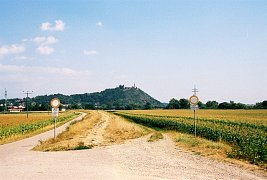
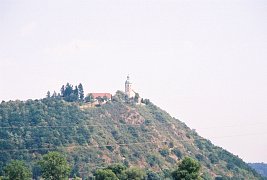 Here in the distance, within sight of Oberaltaich church, is the hilltop
Pilgrimage Church of Our Virgin Mary on Bogenberg Hill. As early as 1223 the town of Bogen's
landmark, Bogenberg Hill, was called "Mountain of Our Virgin Mary". Making a
pilgrimage to the "mountain" is definitely one of the oldest pilgrimages , perhaps even the
oldest in Bavaria.
Here in the distance, within sight of Oberaltaich church, is the hilltop
Pilgrimage Church of Our Virgin Mary on Bogenberg Hill. As early as 1223 the town of Bogen's
landmark, Bogenberg Hill, was called "Mountain of Our Virgin Mary". Making a
pilgrimage to the "mountain" is definitely one of the oldest pilgrimages , perhaps even the
oldest in Bavaria.
|
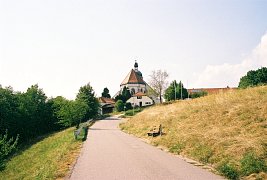 The counts of Bogen ruled this area until
1242 when the last count of Bogen died without an heir.
The pilgrimage church Heilig Kreuz und Mariä Heimsuchung (Holy Cross and Visitation of Our Lady) on the summit of the
Bogenberg about 120 m above the valley was built in 1446-1463 in Late Gothic
style in place of an earlier Romanesque church. The interior decorations in
Rococo style that were added in 1722-1730 were removed in 1876 and were
replaced by Neo-Gothic decorations.
The counts of Bogen ruled this area until
1242 when the last count of Bogen died without an heir.
The pilgrimage church Heilig Kreuz und Mariä Heimsuchung (Holy Cross and Visitation of Our Lady) on the summit of the
Bogenberg about 120 m above the valley was built in 1446-1463 in Late Gothic
style in place of an earlier Romanesque church. The interior decorations in
Rococo style that were added in 1722-1730 were removed in 1876 and were
replaced by Neo-Gothic decorations.
|
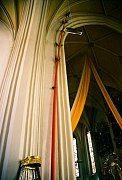 The climax of the pilgrimage year, however, is the great candle-carrying
pilgrimage at Whitsun from Holzkirchen village to Bogen. It goes back to a
vow which the farmers of Holzkirchen in Lower Bavaria made in the 15th
century when their forests were being destroyed by the bark beetle. If
the beetles would go away, then they vowed to carry a huge candle up
the hillside. Since
then, as the Virgin Mary had obviously helped them, 80 to 100 pilgrims
march 75 kilometres every year from Holzkirchen to Bogen, carrying a huge
candle. It consists of a 13 metre long wooden pole around which candle
wax is wrapped in red rings. From the town square of Bogen the candle has
to be carried up the hill in an upright position. Strong young men take
turns to achieve this feat. They are very careful not to drop the candle,
because this, according to a popular belief, would mean that disaster or
war were coming. The candles of the last two years can always be admired
on the right and the left of the altar in Bogenberg Church. Among the other
yearly pilgrimages there is the one of The Virgin Marys Congregation of Men
and the one of the World War II veterans.
The climax of the pilgrimage year, however, is the great candle-carrying
pilgrimage at Whitsun from Holzkirchen village to Bogen. It goes back to a
vow which the farmers of Holzkirchen in Lower Bavaria made in the 15th
century when their forests were being destroyed by the bark beetle. If
the beetles would go away, then they vowed to carry a huge candle up
the hillside. Since
then, as the Virgin Mary had obviously helped them, 80 to 100 pilgrims
march 75 kilometres every year from Holzkirchen to Bogen, carrying a huge
candle. It consists of a 13 metre long wooden pole around which candle
wax is wrapped in red rings. From the town square of Bogen the candle has
to be carried up the hill in an upright position. Strong young men take
turns to achieve this feat. They are very careful not to drop the candle,
because this, according to a popular belief, would mean that disaster or
war were coming. The candles of the last two years can always be admired
on the right and the left of the altar in Bogenberg Church. Among the other
yearly pilgrimages there is the one of The Virgin Marys Congregation of Men
and the one of the World War II veterans.
|
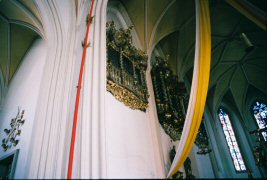 I took this (fuzzy - sorry) picture to show where the rich people sat for mass.
There are several private boxes that are reached through privite entrances to the church.
I took this (fuzzy - sorry) picture to show where the rich people sat for mass.
There are several private boxes that are reached through privite entrances to the church.
|
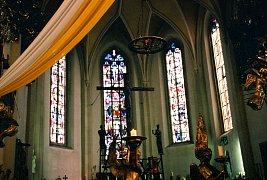
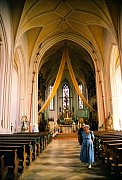 This is a good look inside the church showing the alter and the beautiful stained glass behind it.
This is a good look inside the church showing the alter and the beautiful stained glass behind it.
|
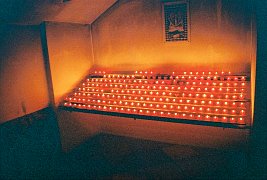 In a room off to the left are candles that the faithful light.
In a room off to the left are candles that the faithful light.
|
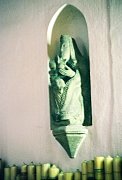 According to the legend, the Romanesque
stone sculpture of Our Lady was found floating upstream on the Danube in 1104.
In 1295 the chronicle of Oberalteich monastery for the first time mentions the legend of
how the miracle-working statue which is worshipped in Bogenberg Church was found.
According to that legend the statue had been floating upstream in the Danube and had
landed on a rock in the river, which appears when the water level is low. This rock is
still called "Marienstein", i.e. Marys stone. Count Aswin of Bogen is said to have recovered
the statue from the rock and to have taken it to the chapel of his castle. Then a church
was built on Bogenberg Hill for the statue and the hill with the church was given to the
monks of Oberalteich, who encouraged the pilgrimage to the miraculous statue. The statue
shows Holy
Mary heavy with child. It is also the reason why many of the pilgrims who came/come to
Bogenberg were/are women praying for a good childbirth.
According to the legend, the Romanesque
stone sculpture of Our Lady was found floating upstream on the Danube in 1104.
In 1295 the chronicle of Oberalteich monastery for the first time mentions the legend of
how the miracle-working statue which is worshipped in Bogenberg Church was found.
According to that legend the statue had been floating upstream in the Danube and had
landed on a rock in the river, which appears when the water level is low. This rock is
still called "Marienstein", i.e. Marys stone. Count Aswin of Bogen is said to have recovered
the statue from the rock and to have taken it to the chapel of his castle. Then a church
was built on Bogenberg Hill for the statue and the hill with the church was given to the
monks of Oberalteich, who encouraged the pilgrimage to the miraculous statue. The statue
shows Holy
Mary heavy with child. It is also the reason why many of the pilgrims who came/come to
Bogenberg were/are women praying for a good childbirth.
|
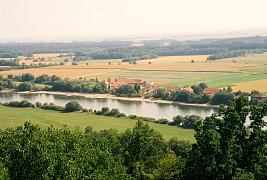
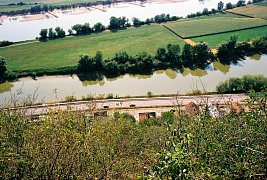 At the right the countryside expands out into very humid beyond. In the picture
at the left the Danube splits into two arms that run parallel for a while.
This shot is taken where the count who rescued the statue of Mary is supposed
to have ridden his horse down when he saw the statue out in the river. Pretty
steep. It is also the area they carry the candle up.
At the right the countryside expands out into very humid beyond. In the picture
at the left the Danube splits into two arms that run parallel for a while.
This shot is taken where the count who rescued the statue of Mary is supposed
to have ridden his horse down when he saw the statue out in the river. Pretty
steep. It is also the area they carry the candle up.
|
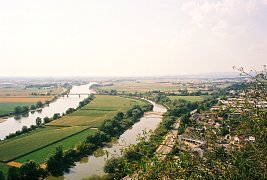
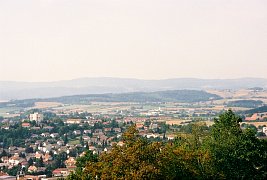 Here you see the two arms of the river (left) and below the hill Bogenville (right).
Here you see the two arms of the river (left) and below the hill Bogenville (right).
|












